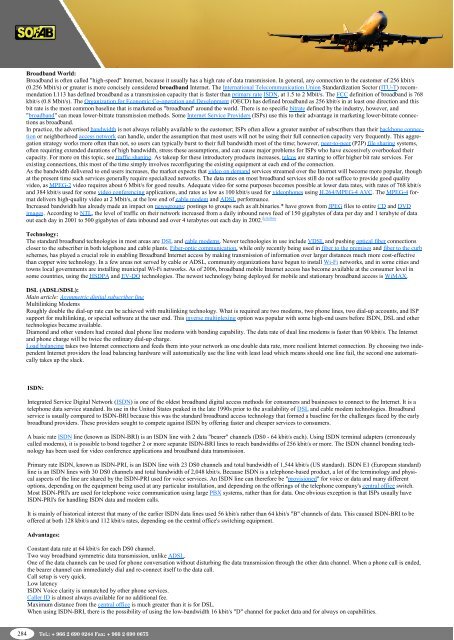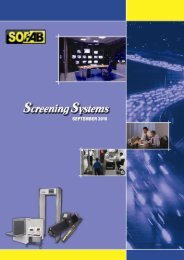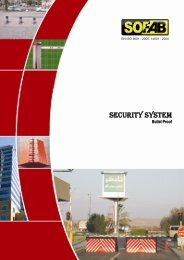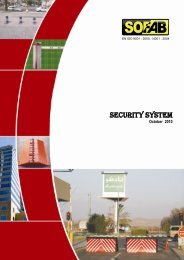CCTV Cameras-2.pdf - Sofab.net
CCTV Cameras-2.pdf - Sofab.net
CCTV Cameras-2.pdf - Sofab.net
You also want an ePaper? Increase the reach of your titles
YUMPU automatically turns print PDFs into web optimized ePapers that Google loves.
Broadband World:<br />
Broadband is often called "high-speed" Inter<strong>net</strong>, because it usually has a high rate of data transmission. In general, any connection to the customer of 256 kbit/s<br />
(0.256 Mbit/s) or greater is more concisely considered broadband Inter<strong>net</strong>. The International Telecommunication Union Standardization Sector (ITU-T) recommendation<br />
I.113 has defined broadband as a transmission capacity that is faster than primary rate ISDN, at 1.5 to 2 Mbit/s. The FCC definition of broadband is 768<br />
kbit/s (0.8 Mbit/s). The Organization for Economic Co-operation and Development (OECD) has defined broadband as 256 kbit/s in at least one direction and this<br />
bit rate is the most common baseline that is marketed as "broadband" around the world. There is no specific bitrate defined by the industry, however, and<br />
"broadband" can mean lower-bitrate transmission methods. Some Inter<strong>net</strong> Service Providers (ISPs) use this to their advantage in marketing lower-bitrate connections<br />
as broadband.<br />
In practice, the advertised bandwidth is not always reliably available to the customer; ISPs often allow a greater number of subscribers than their backbone connection<br />
or neighborhood access <strong>net</strong>work can handle, under the assumption that most users will not be using their full connection capacity very frequently. This aggregation<br />
strategy works more often than not, so users can typically burst to their full bandwidth most of the time; however, peer-to-peer (P2P) file sharing systems,<br />
often requiring extended durations of high bandwidth, stress these assumptions, and can cause major problems for ISPs who have excessively overbooked their<br />
capacity. For more on this topic, see traffic shaping. As takeup for these introductory products increases, telcos are starting to offer higher bit rate services. For<br />
existing connections, this most of the time simply involves reconfiguring the existing equipment at each end of the connection.<br />
As the bandwidth delivered to end users increases, the market expects that video on demand services streamed over the Inter<strong>net</strong> will become more popular, though<br />
at the present time such services generally require specialized <strong>net</strong>works. The data rates on most broadband services still do not suffice to provide good quality<br />
video, as MPEG-2 video requires about 6 Mbit/s for good results. Adequate video for some purposes becomes possible at lower data rates, with rates of 768 kbit/s<br />
and 384 kbit/s used for some video conferencing applications, and rates as low as 100 kbit/s used for videophones using H.264/MPEG-4 AVC. The MPEG-4 format<br />
delivers high-quality video at 2 Mbit/s, at the low end of cable modem and ADSL performance.<br />
Increased bandwidth has already made an impact on newsgroups: postings to groups such as alt.binaries.* have grown from JPEG files to entire CD and DVD<br />
images. According to NTL, the level of traffic on their <strong>net</strong>work increased from a daily inbound news feed of 150 gigabytes of data per day and 1 terabyte of data<br />
out each day in 2001 to 500 gigabytes of data inbound and over 4 terabytes out each day in 2002. [citation<br />
Technology:<br />
The standard broadband technologies in most areas are DSL and cable modems. Newer technologies in use include VDSL and pushing optical fiber connections<br />
closer to the subscriber in both telephone and cable plants. Fiber-optic communication, while only recently being used in fiber to the premises and fiber to the curb<br />
schemes, has played a crucial role in enabling Broadband Inter<strong>net</strong> access by making transmission of information over larger distances much more cost-effective<br />
than copper wire technology. In a few areas not served by cable or ADSL, community organizations have begun to install Wi-Fi <strong>net</strong>works, and in some cities and<br />
towns local governments are installing municipal Wi-Fi <strong>net</strong>works. As of 2006, broadband mobile Inter<strong>net</strong> access has become available at the consumer level in<br />
some countries, using the HSDPA and EV-DO technologies. The newest technology being deployed for mobile and stationary broadband access is WiMAX.<br />
DSL (ADSL/SDSL):<br />
Main article: Asymmetric digital subscriber line<br />
Multilinking Modems<br />
Roughly double the dial-up rate can be achieved with multilinking technology. What is required are two modems, two phone lines, two dial-up accounts, and ISP<br />
support for multilinking, or special software at the user end. This inverse multiplexing option was popular with some high-end users before ISDN, DSL and other<br />
technologies became available.<br />
Diamond and other vendors had created dual phone line modems with bonding capability. The data rate of dual line modems is faster than 90 kbit/s. The Inter<strong>net</strong><br />
and phone charge will be twice the ordinary dial-up charge.<br />
Load balancing takes two Inter<strong>net</strong> connections and feeds them into your <strong>net</strong>work as one double data rate, more resilient Inter<strong>net</strong> connection. By choosing two independent<br />
Inter<strong>net</strong> providers the load balancing hardware will automatically use the line with least load which means should one line fail, the second one automatically<br />
takes up the slack.<br />
ISDN:<br />
Integrated Service Digital Network (ISDN) is one of the oldest broadband digital access methods for consumers and businesses to connect to the Inter<strong>net</strong>. It is a<br />
telephone data service standard. Its use in the United States peaked in the late 1990s prior to the availability of DSL and cable modem technologies. Broadband<br />
service is usually compared to ISDN-BRI because this was the standard broadband access technology that formed a baseline for the challenges faced by the early<br />
broadband providers. These providers sought to compete against ISDN by offering faster and cheaper services to consumers.<br />
A basic rate ISDN line (known as ISDN-BRI) is an ISDN line with 2 data "bearer" channels (DS0 - 64 kbit/s each). Using ISDN terminal adapters (erroneously<br />
called modems), it is possible to bond together 2 or more separate ISDN-BRI lines to reach bandwidths of 256 kbit/s or more. The ISDN channel bonding technology<br />
has been used for video conference applications and broadband data transmission.<br />
Primary rate ISDN, known as ISDN-PRI, is an ISDN line with 23 DS0 channels and total bandwidth of 1,544 kbit/s (US standard). ISDN E1 (European standard)<br />
line is an ISDN lines with 30 DS0 channels and total bandwidth of 2,048 kbit/s. Because ISDN is a telephone-based product, a lot of the terminology and physical<br />
aspects of the line are shared by the ISDN-PRI used for voice services. An ISDN line can therefore be "provisioned" for voice or data and many different<br />
options, depending on the equipment being used at any particular installation, and depending on the offerings of the telephone company's central office switch.<br />
Most ISDN-PRI's are used for telephone voice communication using large PBX systems, rather than for data. One obvious exception is that ISPs usually have<br />
ISDN-PRI's for handling ISDN data and modem calls.<br />
It is mainly of historical interest that many of the earlier ISDN data lines used 56 kbit/s rather than 64 kbit/s "B" channels of data. This caused ISDN-BRI to be<br />
offered at both 128 kbit/s and 112 kbit/s rates, depending on the central office's switching equipment.<br />
Advantages:<br />
Constant data rate at 64 kbit/s for each DS0 channel.<br />
Two way broadband symmetric data transmission, unlike ADSL.<br />
One of the data channels can be used for phone conversation without disturbing the data transmission through the other data channel. When a phone call is ended,<br />
the bearer channel can immediately dial and re-connect itself to the data call.<br />
Call setup is very quick.<br />
Low latency<br />
ISDN Voice clarity is unmatched by other phone services.<br />
Caller ID is almost always available for no additional fee.<br />
Maximum distance from the central office is much greater than it is for DSL.<br />
When using ISDN-BRI, there is the possibility of using the low-bandwidth 16 kbit/s "D" channel for packet data and for always on capabilities.<br />
284 Tel.: + 966 2 683 690 3631 0244 Fax: + 966 2 682 690 6351 0675<br />
Code<br />
J
















